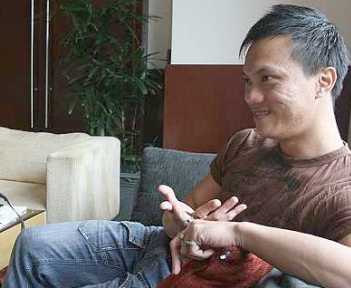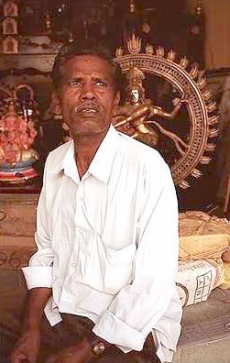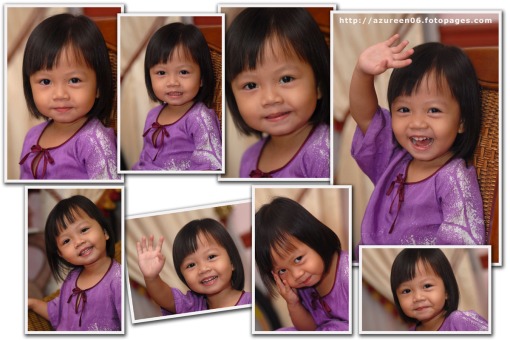Connect with me at Facebook http://www.facebook.com/noor.azam.aziz
My Facebook
17 11 2009Komen-komen : Leave a Comment »
Label: Facebook, Noor Azam, Photography, Zoomer Photography
Kategori : Fotografi - Berita, Uncategorized
Tips : Take Better iPhone Camera Pictures
28 09 2009 Your iPhone
Your iPhone may not be a DSLR, but under the right circumstances it can take some pretty fantastic digital photos. It wasn’t more than five years ago that three megapixel cameras were extremely common in basic consumer photography. Now you have one built into your cellphone! By manually taking the steps most cameras now do automatically, you’ll be able to take digital photos that look as great as any point-and-shoot.
may not be a DSLR, but under the right circumstances it can take some pretty fantastic digital photos. It wasn’t more than five years ago that three megapixel cameras were extremely common in basic consumer photography. Now you have one built into your cellphone! By manually taking the steps most cameras now do automatically, you’ll be able to take digital photos that look as great as any point-and-shoot.
Step 1 – The two most basic differences between an iPhone and a “real digital camera ” are noise and flash. Now that the resolution has improved, these are the last hurdles in achieving truly great digital photos. Both of these problems can be taken care of at once by adding more light to your photos. No matter how well lit a picture is, get more light in there! It may look ok on the screen when you’re taking it, but adding more let will allow the phone to shoot faster, clearer digital photos.
” are noise and flash. Now that the resolution has improved, these are the last hurdles in achieving truly great digital photos. Both of these problems can be taken care of at once by adding more light to your photos. No matter how well lit a picture is, get more light in there! It may look ok on the screen when you’re taking it, but adding more let will allow the phone to shoot faster, clearer digital photos.
Step 2 – Stabilize the camera. Part of the way the iPhone compensates for low light is by taking digital photos slowly. This lets the lens absorb more light to expose the photo. If you move as you’re taking the picture, it’s going to come out blurry. Keep that camera as steady as possible and your digital photos will turn out alright. Brace your arms against your body, or even try holding your breath. Anything to make you move less. Next to setting the camera on something, you best option is to find something to lean on.
Step 3 – Your movement isn’t the only thing you have to worry about. The more the subject of your digital photos is moving, the higher risk of you’ll have of those digital photos turning out blurry. It’s great to strike a pose, but can your subject keep it? Where are they standing? What kind of surface are they on? Are they going to get uncomfortable? Make sure your subject knows they have to stay very still. If all else fails, ditch your friends and go take some digital photos of a rock or park bench. That’ll show them.
Step 4 – The iPhone has some automatic focus, exposure, and white balance features. These are the real tricks for something professionally taking digital photos – and you can use them too. Older phones had to make sure the subject of their digital photos was about 8-10 feet away in order to be in focus. The camera also had to use a small aperture to keep everything in focus, resulting in a darker and more noisy photo. Now you can move your subject a good distanct away from their background, tap directly on them to ensure they’re the focal point of the digital photos, and take the picture.
Komen-komen : 2 Comments »
Label: Camera, iPhone, Photography
Kategori : Fotografi - Artikel, Fotografi -Tips
Zoomer di Facebook
24 09 2009Anda, kenalan anda atau siapa sahaja boleh bersama kami di Facebook
Hubungi saya, rakan-rakan saya, atau anda boleh mencari rakan2 anda yang telah terputus hubungan sejak berpuluh tahun dulu. Sesiapa juga boleh menjadi ahli – dengan PERCUMA. Hanya klik http://www.facebook.com/noor.azam.aziz
Komen-komen : Leave a Comment »
Label: Facebook, fotografi, Photography
Kategori : Fotografi - Berita, Fotografi -Tips
Goo-goo, Gaa-gaa! Awww, SO CUTE!
30 08 2009Source: The Malay Mail
Candid shots of babies bring the sweetest memories
![]()
In this digital age, running businesses online has become the norm. From rare collectibles to services, they’re all just a click away.
Two mothers, Low Soo Lyn (better known as Sue) and Jasmine Chong, turned to the blogosphere for just that.
These women are self-taught photographers who started indulging in photographing babies and children some three years ago.
They are just so lovable and adorable, cooed the working mums.
Jasmine has two children while 32-year-old Sue has three. They prefer to remain behind-the-camera and have requested not to have their mugs featured.
![]() Regardless, taking a look at their artistic shots at http://two-pixels.net, you can’t help but fall in love with the plethora of shots Jasmine and Sue have done.
Regardless, taking a look at their artistic shots at http://two-pixels.net, you can’t help but fall in love with the plethora of shots Jasmine and Sue have done.
“It all started with Sue’s idea of taking photographs of newborns for friends. Thereafter, we decided to take this little hobby of ours to the next level,” said Jasmine, 31, about the birth of their photoblog, which is very young, only nine months old.
“Now, we not only photograph newborns but we also take pregnancy shots, family photos and pictures of young children. This is simply because photographing the newborn is still a very new concept for Malaysians and many times, parents are very skeptical about stripping down their babies,” explained Jasmine.
“Most of our customers are referrals from friends or blog hoppers. Initially, we started off with a circle of new mums, whom we got to know via the blogsphere, and they helped spread the word around.
“Nowadays we are looking at customers who reached us via the World Wide Web,” said Jasmine. What’s so unique about Two Pixels, said the mums, are their shooting locations.
The first is an outdoor spot near the client’s home and the other is an indoor locale in the home.
“We believe that everyone is most comfortable in their home, which is why we want photographs to be taken at home, not in a studio.”
Sue and Jasmine do everything themselves – from photographing to post-processing – alleviating any unease and apprehension parents may feel.
Here is how Two Pixels view the blogosphere.
How challenging has it been to set up and maintain the blog?
The challenges we faced, being two sceptical mums, is our blog design. It took us days to decide the design and colour scheme.
Maintaining the blog itself is also a challenge because we have so many photoshoots back-to-back, but we try our best to keep the blog alive by putting up posts at least two or three times a month.
SMILE! A cute baby photo like this will make anyone's day
(Both mums also have their own blogs focusing on their kids. Check out Jasmine’s blog at http://jazzmint.net/blog/ and Sue’s at http://lilpeople.net/blog/)
What would you really like to achieve through your blog?
We hope that with this blog we will be able to reach out to more parents and parents-to-be out there to engage our service.
What does “Blogosphere” mean to you?
A network that connects you to countless opportunities
Who is your absolute favourite blogger?
The list is just too long, but we enjoy blog-hopping to various photographers’ websites, mostly to get inspiration and ideas.
What is the foremost feature in the Blogosphere that irritates you?
Spam. We get them day-in, day- out in our blog and they are pretty irritating. Despite the fact that we block IP addresses, new spammers just keep popping up.
If there was someone you could influence to take up blogging, who would it be?
All mothers out there who are not blogging, start one today! It’s a great way to keep an online journal of our children.
All photos are courtesy of Two Pixels Photography.
Komen-komen : 1 Comment »
Label: Baby Photographer, Photography
Kategori : Fotografi - Artikel, Fotografi - Berita, Fotografi - Interview
Soraya finds Success in portraits
30 08 2009Source: The Star
A Malaysian photographer shares her story-within-a-story with New Yorkers through her Imaging Selfs exhibition in Manhattan.
 WHILE some people see dyslexia as a learning disability, Soraya Yusof Talismail sees it as a gift.
WHILE some people see dyslexia as a learning disability, Soraya Yusof Talismail sees it as a gift.
Soraya (pic, right), 40, is often described as one of Malaysia’s finest portrait photographers who includes among her subjects luminaries like Queen Elizabeth II and the late Yasser Arafat.
She is also dyslexic. Grappling with numbers, symbols, and written words can be quite a task, she admits, but this is compensated by an astute observation of things around her and an ability to think in terms of pictures.
Her childhood ambition was to be an architect but she failed to qualify for the course in college as she was “no good with numbers”, Soraya confided during an interview.
Fate had something else lined up and she pursued photography at ITM instead. That was some 20 years ago. Soraya has had no regrets, describing her career as a “successful arranged marriage” where she has grown to love photography.
Her talent and creativity have taken her to interesting places, the latest being the Big Apple, where she held a solo exhibition entitled Imaging Selfs: New York last month.
Soraya was invited by Eng Tay, a Malaysian-born artist who has made NYC home for more than 30 years, to hold her exhibition in conjunction with the launch of his ETAY Gallery in Broadway, Manhattan.
The exhibition showcases Soraya’s portraits of 26 Malaysian artistes who have made it big on home ground or elsewhere and have some ties with the US, either through their arts foundation, exhibitions, or their own merit or have been influenced by American pop culture or creative sentiments.
It is a spin-off from Soraya’s Imaging Selfs exhibition held at the Petronas Gallery in Kuala Lumpur last November, featuring black and white portraits of 80 Malaysian artistes. Imaging Selfs is the culmination of a 15-year project started when a young Soraya, fresh out of college, wanted to capture the portraits of Malaysian talents and bring out the essence of their personalities.
Then 24, Soraya relentlessly trailed some of the biggest names in the arts from state to state, trying to fix appointments, persuading them to have their portraits taken and planning location shoots. To finance her artistic project she did formal portraits.
By the time her Imaging Selfs portraiture exhibition was held, Soraya had immortalised many of Malaysia’s finest artists on print.
They include the late movie director Yasmin Ahmad whom Soraya described as one of the easiest persons to work with, renowned painter sculptor Yeoh Jin Leng, choreographer/dancer Marion D’ Cruz, visual effects artist Shahril Ibrahim, Malaysia’s pop princess Datuk Siti Nurhaliza, Eng Tay, fellow photographer Eric Peris, musician composer Jenny Chin, and fashion designer Bernard Chandran.
The list goes on. But what stands out in her artistic works is that no one race dominates.
“I don’t see our artistes as Malay, Indian, Chinese, Sabahan or Sarawakian. To me, they are all talented Malaysians who have contributed to the country and who we should be proud of,” she said.
Apart from performing artistes who often appear before large crowds, many of her subjects were incredibly shy people who needed to be persuaded to go before the camera.
It took her almost 10 years to get playwright Dr Noordin Hassan to finally agree to have his portrait taken, Soraya recalled.
The first artist she photographed for the project in 1994 was a good friend, Bayu Utomo Radjikin, a founder member of the Matahati art group. Some of the artistes are friends of her husband Ariff Awaluddin, an artist-photographer who also runs a bistro in Petaling Jaya.

Interesting work-of-art: Visitors at Soraya’s exhibition in Manhattan.
Many artistes featured in the New York exhibition had explored their beginnings in the US. Jenny Chin, Mac Chew and Acis were products of the Berklee College of Music, artist photographer Ismail Hashim went to Washington State University, while Latiff Mohidin attended Pratt Institute in New York. Choreographer dancer Ramli Ibrahim has performed from coast to coast.
Soraya’s first SLR camera was a Nikon FG and till today, she prefers the conventional camera to the digital camera for her portraits; she believes film gives better tonal quality.
Soraya and Ariff love travelling and spend over a month each year visiting exotic and interesting places with their 11-year-old son Ushuaia.
Soraya said her travels, sometimes coinciding with her exhibitions or talks on photography, have given her a better insight, not just of the world but also of things back home.
For Soraya, holding the New York exhibition has been a challenging experience.
“We had to do everything ourselves, from getting the artwork ready, seeking funds, planning our flights from KL, accommodation, designing the catalogue, sending out invitations, and even preparing the refreshments!”
Still, holding an exhibition in the Big Apple is a personal triumph for Soraya. Her Imaging Selfs is her story within a story – a journey that carries with it the artistic journeys of her peers.
Komen-komen : Leave a Comment »
Label: Photography, Soraya Yusof Talismail
Kategori : Fotografi - Artikel, Fotografi - Berita, Fotografi - Biografi
Photojournalist captures unusual scenes for all over the world
29 04 2009Source : The Star
TO EVAN YH-Hwong, photography is a form of expression, a form of art and enables him to indulge in his passion for showing the world what he sees through the lens.
“I’m combining my passion for photography with what I learnt in university and translating what I observe into art,” said the 29-year-old who is better known as Evan Hwong.

He picked up photography to deal with the stress of studying for his Business Psychology degree at Leeds Metropolitan University, and has been shooting professionally since 1997.
Hwong is a documentary photojournalist for several stock photo agencies around South-East Asia and is presently DeviantART.com’s Photojournalism Gallery director.
He favours film (over digital), as he prefers the texture and tonality that films create.
He switches between black-and-white and colour mode, depending on the impact he wants to create, though he has an affinity for the black-and-white mode in vertical format as “the focus is on the details and tells the message directly”.
Hwong’s “weapons” would primarily be the Canon EOS 300 and Canon EOS 500N for colour and black-and-white films respectively.
He also owns a couple of digital SLR cameras that he uses when the occasion calls for it.

Look of longing: The title `Let Me Go Home’ says it all in this photo.
The Sarawak-born lad has been travelling on his own to various places in Europe, North America, Asia and Australia since he was 15.
“I enjoy seeing and experiencing different cultures. It gives me a fresh perspective of things,” said Hwong.
“I love to walk because that’s when I get to see so much more. It offers an opportunity to see what goes on in the back lanes or hidden areas that people don’t normally see.”
His recent collection of work is themed Hidden Valley, which he said represented the nitty-gritty sides of the Klang Valley that people tend not to notice or chose not to.
Most of the photos were taken within the KL vicinity in areas like Petaling Street and Masjid India.
These photos, like most of his work, require more than just a mere glance as one ponders on the messages that each conveys.
It helps that Hwong gives them interesting titles that create additional food for thought.
“The titles could be a parody or reflective of the photo. But I don’t give away too much because I want the viewers to create the story based on what they see.”
According to him, a documentary photojournalist needs to be able to blend in with his surroundings; interact well with people; have a quick, judgmental mind to anticipate what happens next and artistic skill.
“Your photographs must always tell a story. It’s important, and it takes years to develop this ability.
“You must immediately know which type of shot you want. It takes a lot of practice to photograph in a sniper sharp-shooter style.
“All it takes is three seconds to get the right composition; you aim, focus and shoot to capture the shot.
“For your own safety, you need to know your own surroundings including escape routes, and locations of the nearest taxi stand, police station and hospital,” stressed Hwong.
He cited an example when he had to dash for the nearest taxi after capturing the shot entitled Buffet Lines, as his action had been noticed by the syndicate members operating the pirated disc business.
To view his work, visit estudio.deviantart.com/gallery.
Komen-komen : 1 Comment »
Label: Photography, Photojournalist
Kategori : Fotografi - Artikel, Fotografi - Interview
A picturesque venue to hold a wedding
22 03 2009WHEN scouting for ideal locations for a wedding photography shoot, there are couples who opt for the majestic backdrops of Putrajaya.
Spurred by this and on the basis that Putrajaya has something different to offer, the Putrajaya Tourism Action Council (PTAC) is holding a fair geared at those intending to tie the knot.
The Putrajaya Wedding Festival 2009 will be held at the Putrajaya International Convention Centre (PICC) on March 28 and 29 with the cooperation of Tourism Malaysia and the Unity, Culture, Arts and Heritage Ministry.
At a recent press conference, PTAC general manager Junus Suhid said he hoped the fair would also boost tourist arrivals to Putrajaya.
“One of the festival’s components is the familiarisation trip for 40 tour agents from Taiwan, Hong Kong, China, Vietnam and Cambodia. We also hope to draw 20,000 to 30,000 visitors to the fair daily,” he added.
The festival will feature between 40 and 50 booths showcasing the weddings of major and minor ethnic groups, namely the Malays, Chinese, Indians, Sarawakians, Sabahans, Sikhs and orang asli.
Cultural events, a photography exhibition, seminar and workshop on photography and a wedding seminar have been lined up.
The wedding seminar will include a talk on royal wedding fare by celebrity chef Wan Ismail, the importance of health checks before nuptials and wedding planning by other speakers. Entrance to the festival, held from 9am to 9pm daily, is free.
Komen-komen : Leave a Comment »
Label: Photography, Putrajaya, wedding
Kategori : Fotografi - Aktiviti, Fotografi - Berita
Fotografi Kanak-Kanak – Aksi & Ekspresi
26 01 2009

Model : Nisrina Azureen
Untuk melihat lebih banyak imej-imej Azureen, sila lawati http://azureen06.fotopages.com
Untuk mendapat lebih banyak tips tentang Fotografi Kanak-Kanak, sila klik https://myfotografi2u.wordpress.com/2008/08/20/tips-fotografi-kanak-kanak/
Komen-komen : 1 Comment »
Label: fotografi kanak-kanak, Nisrina Azureen, Photography, tips
Kategori : Fotografi -Tips
Tips: GAMBAR LANSKAP
10 12 2008Pengambilan gambar lanskap tidak terhad kepada pemandangan bukit-bukau, laut atau sawah padi sahaja kerana anda boleh memasukkan unsur-unsur seperti langit, air (sungai, laut, tasik dan sebagainya) serta bangunan.
Untuk gambar lanskap, anda tidak perlu pergi jauh kerana persekitaran tempat tinggal anda juga mempunyai keindahan tersendiri. Contohnya di tempat saya ada Air Terjun Sungai Tekali, Empangan Semenyih, Banjaran Titiwangsa, sawah padi di Beranang, Bangunan kilang di kawasan perindustrian Beranang, tasik di Bdr Tasik Kesuma, ladang getah di Rinching, dan banyak lagi.
Awal pagi dan waktu senja merupakan waktu yang sesuai untuk mengambil gambar lanskap. Antara sebabnya ialah ia berupaya memberi kesan cahaya yang berbeza dari biasa. Kabus di sebelah pagi, dan cahaya suram kemerahan di sebelah senja, pastinya memberi kesan emosi pada gambar yang dirakam. Keupayaan anda memberi PERASAAN pada gambar anda, pasti memberi impak yang besar pada mereka yang melihat. Itu kejayaan paling memuaskan pada setiap fotografer.
Untuk menghasilkan gambar lanskap yang menarik, lensa sudut luas amat sesuai digunakan kerana ia memberi skop yang amat luas. Hasilnya, ia boleh memberikan details yang lebih terperinci bagi lanskap yg hendak kita rakamkan itu. Contohnya, jika kita mengambil lanskap sawah padi, di samping memasukkan unsur langit, horizon, bukit bukau, dan sawah padi, kita juga boleh memperlihatkan helaian daun dan butir-buah padi di dalam satu keping gambar jika kita menggunakan lensa sudut luas.
Sekiranya ingin memasukkan kaki langit (horizon), anda boleh meletakkan kaki langit samada di tengah-tengah gambar, di atas atau di sebelah bawah mengikut imaginatif anda. Ia juga bergantung kepada apa yang sebenarnya ingin anda tonjolkan. Jika hendak menonjolkan awan yang berkepul dan kebiruan langit, letakkan horizon anda di bawah. Sebaliknya jika hendak menonjolkan permukaan pantai bersama sampan atau bukit bukau yang serba hijau, letakkan horizon anda di sebelah atas. Pasti gambar anda jadi sangat menarik.
Komen-komen : Leave a Comment »
Label: fotografi, lanskap, Photography, tips
Kategori : Fotografi - Artikel, Fotografi -Tips
Malaysian Nationals Invited to Join “Works of Freedom” Photography Contest
12 11 2008 To mark the 60th anniversary of the Universal Declaration of Human Rights (UDHR) and the 10 December World Human Rights Day, the Friedrich Naumann Foundation Alumni Network (FAN) Malaysia will hold a photography contest and exhibition under the title of “Works of Freedom”.
To mark the 60th anniversary of the Universal Declaration of Human Rights (UDHR) and the 10 December World Human Rights Day, the Friedrich Naumann Foundation Alumni Network (FAN) Malaysia will hold a photography contest and exhibition under the title of “Works of Freedom”.
As the title suggests, the contesting photos will feature activities or reveal commitment to the promotion or achievement of freedom that all human beings deserve regardless of nationality, race or faith.
For years FAN Malaysia has voluntarily worked to raise the awareness and importance of freedom, and this photography contest is its latest activity to promote the value of human liberty. All entries will be featured at the “Works of Freedom” exhibition on 1-7 December 2008 at the Galeri Pelita Hati, No. 22 Jalan Abdullah, off Jalan Bangsar, 59000 Kuala Lumpur.
Malaysian nationals are welcomed to join the contest by sending their photos to the SEDAR Institute between now and 15 November 2008. Photos received by the organiser will be displayed and sold at the exhibition. Proceeds will be used entirely for the benefit of promoting freedom in the Malaysian society.
At the photo exhibition, visitors will also enjoy the reading of poems on the subject of “freedom,” musical performance by Meor and Black, special presentation by renowned painter and photographer Wong Hoy Cheong.
Deputy Information Minister YB Tan Lian Hoe will preside over the closing ceremony of the “Works of Freedom” on 7 December when the winners for the contest will be announced. The minister will present prizes to the 13 winners who will each receive a certificate of achievement, trophy and RM500 cash.
All the 13 winning entries will be featured in the FAN Malaysia 2009 Calendar. Copies of the calendar will be distributed to FAN Malaysia members and members of its partner organisations across the country.
For more infos, please visit http://www.fnfmalaysia.org/www/
Komen-komen : Leave a Comment »
Label: contest, Photography
Kategori : Fotografi - Aktiviti, Fotografi - Berita





Komen Terbaru